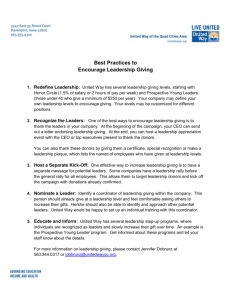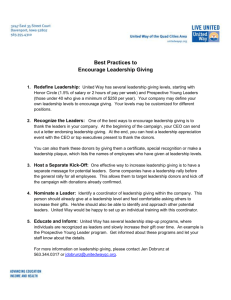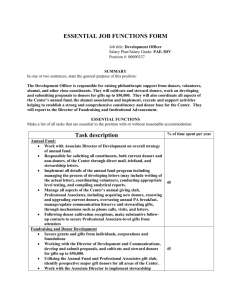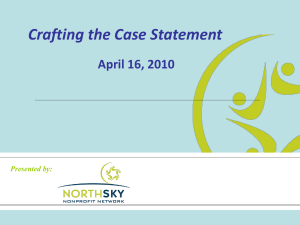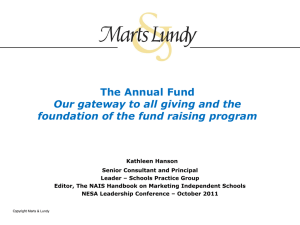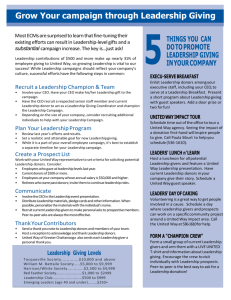Fundraising at the U of M
advertisement
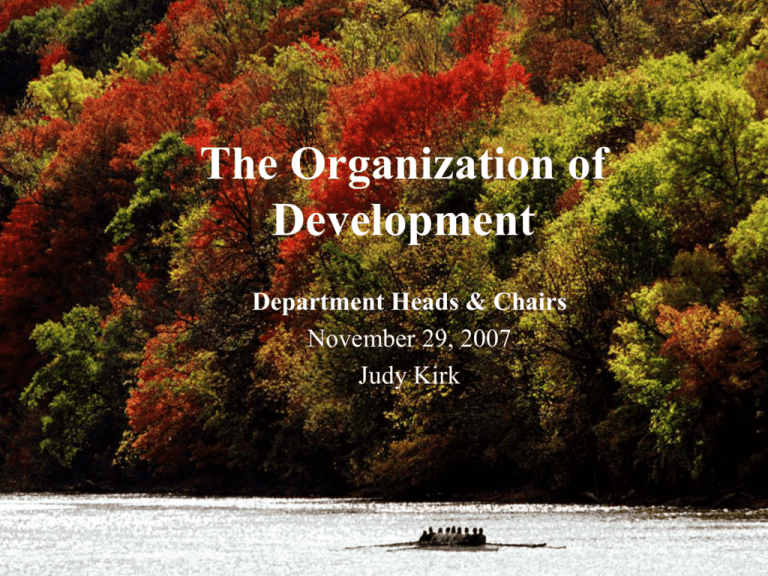
The Organization of Development Department Heads & Chairs November 29, 2007 Judy Kirk University Vision Development Mission To engage the resources of the private sector to build and sustain excellence at the University of Minnesota. Why We Were Formed The University of Minnesota Foundation was formed to accept and manage gifts on behalf of the University and its colleges, campuses and programs. Specifically, it: • Exists to support the University’s interests. • Secures, manages and invests private support for the benefit of the University. • Provides private support for a portion of the operations or programs of the University. • Uses sound fiscal and auditing procedures. • Obtains and maintains status as a tax exempt organization. Fundraising at the U of M UMF relationship with the University includes development oversight and services: • Strategic U-wide development leadership • Campaign planning and implementation • Delivery of comprehensive development services for Uwide Development (i.e. technology, legal, donor relations, gift administration, annual giving, communications) • Financial subsidies to collegiate development programs • Endowment investment management • Assessments across colleges/programs for continued program support or new investment Historical: Campaign Summary 1985-88, Minnesota Campaign Focus: 100 endowed faculty positions Result: 111 added 1989-96, Mini-Campaigns Focus: New & renovated facilities Weisman, Ted Mann Concert Hall, Mariucci Arena, Williams Arena & Sports Pavilion 1997-03, Campaign Minnesota Focus: Support for faculty, students, facilities & research Result: All goals exceeded 2004-Now, Mini-Campaigns Focus: Scholarships, fellowships, new facilities On-campus stadium, translational research, Carlson School addition, Bell Museum, Equine Center, Weisman addition Campaign Minnesota Highlights Campaign Minnesota: A Historic Achievement • $1,655,703,867 raised, or 127% of goal • 220,000 donors • Major impact on faculty and students What this means for future of fund raising at the U • A 30% increase in number of donors • 113,000 first-time donors • 11,000 faculty and staff donors Historical: Gift Production Minnesota Campaign Non-Campaign Campaign Minnesota 2-year Average: 26 51 76 2007 2006 2005 2004 2003 2002 2001 2000 99 98 97 96 95 94 93 92 91 90 89 88 87 86 85 84 83 82 240 220 200 180 160 140 120 100 80 60 40 20 0 216 Impact of Giving Who donates? (FY07) 87,167 total donors Corporations, foundations, organizations– 5,123 donors $70M 6% 28% Individuals (non-alum) – 34% 29,369 donors $70M 58% Faculty/Staff – 1,602 donors $14M Donors of 2007 Gifts 2% Alumni – 51,073 donors $97M National Rankings Growth in Voluntary Support (in millions) $ 300 250 $265 $267 $233 $239 $246 2002 2003 2004 2005 2006 14 4 15 7 15 5 14 5 14 4 200 150 100 50 0 National ranking among: Public & private universities Public universities only National Rankings Voluntary Support of Education - 2006 (In Millions) Private and Public 1. Stanford 2. Harvard 3. Yale 4. Pennsylvania 5. Cornell 6. Southern California 7. Johns Hopkins 8. Columbia 9. Duke 10. Wisconsin $911 595 433 409 406 406 377 377 332 326 11. UCLA 12. Washington 13. New York U 14. Minnesota 15. Northwestern 16. Michigan 17. Indiana 18. UC - Berkeley 19. U of Chicago 20. UNC – Chapel Hill $320 316 280 267 253 251 248 246 237 237 Impact of Giving Combined University Endowments (in millions) As of June 30 $ 3,000 $2,819 262 2,500 $2,255 $1,965 2,000 $1,728 $1,515 1,500 1172 204 187 177 224 Minnesota Medical Foundation 876 772 University of Minnesota 654 1,000 553 University of Minnesota Foundation 1385 500 785 887 989 1155 0 National ranking among: 2003 Public & private universities 25 Public universities only 6 2004 2005 2006 2007 25 6 25 6 25 6 na na Impact of Giving - Highlights • 404 endowed chairs* from 17 in 1985 • $191.3 raised for Scholarship Campaign. Growth in scholarships and fellowships*: • 378 fellowships, 463 scholarships Endowment exceeds $407M. 46% increase in # of students receiving support. $128M raised, Campaign Minnesota. Built, renovated 25+ facilities, including -Architecture addition -Microbial & Plant Genomics -Amundson Hall -Weber Music Hall, UMD -Studio Arts -Andersen Library -Mechanical Engineering -Science Building, UMD -Law School addition *As of October 31, 2007 -McNamara Alumni Center -Murphy Hall -Barbara Baker Dance Center -Showboat -Fitness Center, Morris -Arboretum Visitor & -Learning Centers -Densford Nursing Center -Translational Research National Giving Trends Multimillion-dollar gifts from donors seeking to change the world—a huge opportunity! • Donors not motivated by needs as much as by opportunities • • Interdisciplinary programs attract leadership gifts Growing interest in seeing immediate impact Donors want to see results, accountability • Increasingly, donors want to know the measurable outcomes before sizeable gift Sources of support are changing • • Alumni support critical to successful campaigns Corporate funding growing at much slower rate than in recent past Demand increasing for good, experienced fundraisers making a Critical Success Factors A Compelling Case Aligns U’s vision, strengths, priorities with donors’ dreams, passions & goals. Critical Success Factors Transformational Gifts: Possess unique capacity to alter the programs, perception and future of an organization; Traditionally defined by the impact on an organization, and size relative to the overall budget. “People no longer give to charity, they buy into results.” –Peter F. Drucker, renown business writer, management consultant & university professor UMN transformational gift level $25 million+ Critical Success Factors Transformational Gifts Nationally, largest 10 gifts to universities Totaled $757M or average of $76M each. 7 went to private schools; 3 to publics. 8 from alumni of those institutions. U’s Experience • Twelve $10 Million + gifts in last decade 11 business founders or executives 10 were alumni 9 were volunteers prior to the gift Age range 56-85; median, 66 Why did these alumni give? Passion for, connection to the institution Desire to have an impact on the world Critical Success Factors Leadership Commitment & Focus Integration of private support into U’s longrange planning. U leaders committed to building strong relationships with alumni, donors. Volunteer leaders meaningfully engaged in life of U & fund-raising. Critical Success Factors Volunteer Commitment & Engagement • Energetic force that drives momentum of • • • • campaign success U’s front-line advocates Expand networks and access to additional prospects Share indispensable expertise Give of their own time and financial resources Critical Success Factors A Top-Quality Development Operation • • • • Ability to attract, retain top professional talent. Effective coordination in decentralized culture. Strong central services. Budget appropriate for the potential. – Cost to raise $1 at the UofM has averaged only 9.4 cents annually for past decade. – ROI: $7-$15 raised for each $1 invested in development Relationship with College/Unit UMF Strategic Partnerships Collegiate Development Colleagues • New employee orientation • Monthly development meetings • Training opportunities • Donor consultation • Central development services • Rewards and recognition Chancellors/Deans/Directors • Search process consultation (descriptions, search committee resources, networking) • Financial subsidy • Compensation consultation and market analysis • Performance management consultation • Development strategy consultation Relationship with College/Unit Your Chief Development Officer: • • • • • • Is a trained professional in major gift fund raising Understands your unit’s mission of work Has great “people” skills Has passion and commitment Has high ethical standards Is donor-centered Relationship with College/Unit How you can help your CDO: • Have trust in their expertise and experience • Be patient: building long-term relationships takes time • Get involved: help your development officers understand your goals and be available to help donors learn more about you • Adopt a long-term vision Giving Trends Motivations for giving • To leave a legacy • To support things they care about • To support a passion for a cause or vision • To give back in gratitude for what his/her University did for them Why People Give Larry and Nancy Bentson •• Following family tradition of giving. • Established endowment for undergraduate scholarships with $10 million gift in 2005. • In the first year, 66 students were Bentson Scholars. This school year The Bentson Family Scholarship will provide 185 students with about $5,000 annually for four years or more. • The Bentsons have led lives rich with loving family, friends and financial prosperity. Now they want to help students experience the same.

